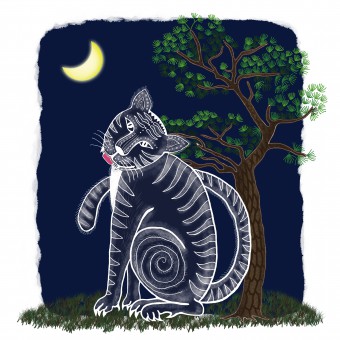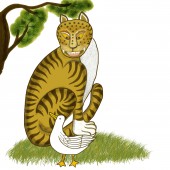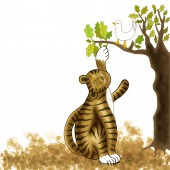
| THE AWARD |
| CATEGORIES |
| REGISTRATION |
| SUBMIT YOUR WORK |
| ENTRY INSTRUCTIONS |
| TERMS & CONDITIONS |
| PUBLICATIONS |
| DATES & FEES |
| METHODOLOGY |
| CONTACT |
| WINNERS |
| PRESS ROOM |
| GET INVOLVED |
| DESIGN PRIZE |
| DESIGN STORE |
| THE AWARD | JURY | CATEGORIES | REGISTRATION | PRESS | WINNERS | PUBLICATIONS | ENTRY INSTRUCTIONS |
Moonlight Tiger Graphic Folk Painting by Nanyoung Jeon |
Home > Winners > Design #126816 >Interview |
 |
|
FS: What is the main principle, idea and inspiration behind your design?
NJ: This is a work that personifies me who was alone. Tigers are mountain owners, but tigers cannot be friends with animals that live in the mountains. To a lonely tiger, the moon is a good friend. I put a human character in an anthropomorphic animal. And then I put the emotion in it and put the story on it.
FS: What has been your main focus in designing this work? Especially what did you want to achieve?
NJ: When I designed the tiger character, I embodied my partner. He also has similar characteristics to tigers. I thought about how to best express his characteristics. And I wanted to include a story. I thought about how to express the agony of the tiger. An animal with great energy has no friends. Likewise, a person with great energy has no friends. People with great energy make friends with Mother Nature through the world. I wanted to put that meaning in the painting.
FS: What are your future plans for this award winning design?
NJ: One of the Korean folk painting is Sun and Moon and Five Peaks. It was a folding screen used in the background of the royal palace, and although Sun and Moon and Five Peaks is a royal work, it will be painted in a commoner's version. Sun and Moon and Five Peaks is the image of the universe and a property of Mother Nature. It's a painting that expresses the world divided into yin and yang in harmony.
FS: How long did it take you to design this particular concept?
NJ: It took about a month.
FS: Why did you design this particular concept? Was this design commissioned or did you decide to pursuit an inspiration?
NJ: It was a picture drawn on mobile with a pen of Samsung Galaxy Note 7 in 2017. These were drawings of mobile devices as a test at the time, and I'm happy to receive this award. After I finished drawing, there was a cell phone recall, so I returned the cell phone after 8 months. This picture is a thoroughly mobile application.
FS: Is your design being produced or used by another company, or do you plan to sell or lease the production rights or do you intent to produce your work yourself?
NJ: It's not being used by another company. I'm willing to sell the production rights.
FS: What made you design this particular type of work?
NJ: At that time, it was before I opened my company, and it was a foggy time in my life. I spent a lot of time alone, and after changing my cell phone, I tested and drew pictures on mobile devices. That's how I started graphic fork art. I was a Korean traditional embroidery artist before graphic folk art. I obtained a professional certificate from an intangible cultural asset. As I won awards for my embroidered work, I came across the field of folk paintings and fell in love with them. I've changed from a tool called embroidery to a tool called graphics, and I've been continuing my folk painting.
FS: Where there any other designs and/or designers that helped the influence the design of your work?
NJ: Folk paintings are paintings by unknown artists of Joseon Dynasty ancestors. There are many paintings mainly by women in folk paintings. At that time, men could leave their names behind, but women did not leave special names. My works are a graphic translation of the works of my past nameless ancestors, and I just have a little technique and design in it.
FS: Who is the target customer for his design?
NJ: I didn't set a specific target for the design. The picture I drew as a practice happened to be elected, so I thought I should work harder on this graphic fork art.
FS: What sets this design apart from other similar or resembling concepts?
NJ: Among Korean folk paintings, there are many folk paintings of tigers. Most tiger folk paintings look forward to the front with up to . My painting tried to express the loneliness of a tiger. That is, it is a picture of a tiger with emotion. That's the difference between my work and tiger folk paintings.
FS: How did you come up with the name for this design? What does it mean?
NJ: I thought about how to express the loneliness of a tiger. Since tigers are active at night, I thought I should draw tigers with the moon. The tiger looking at the moon was named Moonlight Tiger because it tried to express the loneliness of the tiger with emotions as if talking with the moon.
FS: Which design tools did you use when you were working on this project?
NJ: I used the Samsung Galaxy Note 7 paint app. After that, the modification work was done with Photoshop.
FS: What is the most unique aspect of your design?
NJ: I tried to express the emotional state of the tiger in the illustration, and I wanted to make a story by appearing a tiger and a duck. The bad-tempered tiger is my partner and the duck is me. In the last scene, the smoking tigers are my partner and me.
FS: Who did you collaborate with for this design? Did you work with people with technical / specialized skills?
NJ: I worked alone.
FS: What is the role of technology in this particular design?
NJ: It's a graphic translation of a folk painting. I drew the picture that my ancestors used to paint with a brush on Korean paper, replacing it with a brush of Photoshop.
FS: Is your design influenced by data or analytical research in any way? What kind of research did you conduct for making this design?
NJ: I searched many Korean folk paintings. I looked at how tiger folk paintings were expressed, and as a result, my tiger was born.
FS: What are some of the challenges you faced during the design/realization of your concept?
NJ: After the recall of the Samsung Galaxy Note 7, it was difficult to return the cell phone in eight months. All the Galaxy Note 7 were recovered from the battery explosion and I had to back up all the pictures and buy another cell phone.
FS: How did you decide to submit your design to an international design competition?
NJ: After returning the cell phone, I put the pictures I had drawn inside on Naver <grafolio> and forgot about it for several years, but one day, the person in charge of the award received an e-mail saying that the moonlight tiger and Haitai were nominated and submitted.
FS: What did you learn or how did you improve yourself during the designing of this work?
NJ: When I first designed the work, I designed it according to the size of my cell phone, but there is an international design standard, so I thought I should design it according to the standard from next time. As I designed it in a small cell phone size, I think I need to improve the details that I missed. And because I designed it for practice, I couldn't make the theme and story of the painting properly. I learned that when designing from now on, I have to design by setting the design direction and purpose target from the beginning.
FS: Any other things you would like to cover that have not been covered in these questions?
NJ: How do you feel about the competition? While working on international design for the first time, I thought simple and easy at first. I never thought it was such a big competition. Since it is my first international competition, I participated in it with the thought of practicing. However, as the competition ended, I didn't realize how big the competition was and how influential the award was until I received the award. After receiving the award, I learned many things through public relations and many processes. It was also an opportunity to think about the work of design, and I think it was an opportunity to be reborn as a designer. Thank you very much for this opportunity.
FS: Thank you for providing us with this opportunity to interview you.
A' Design Award and Competitions grants rights to press members and bloggers to use parts of this interview. This interview is provided as it is; DesignPRWire and A' Design Award and Competitions cannot be held responsible for the answers given by participating designers.
| SOCIAL |
| + Add to Likes / Favorites | Send to My Email | Comment | View Press-Release | Translations |




